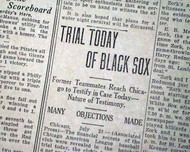Gambling on baseball is a very sensitive subject and to understand why all you need to do is wind the clock back almost 100 years and look at the 1919 World Series between the Cincinnati Reds and the Chicago White Sox.
Fans who know the history of the game are aware that there was a scandal and that White Sox players conspired with gamblers to throw the Series, but not too many know some of the more interesting facts.
Here’s look back at the Black Sox Scandal:
 The term “Black Sox” was around before the 1919 World Series. White Sox owner Charles Comiskey was so cheap that he reduced the number of times the players’ uniforms were washed. The dirty uniforms gave rise to the term Black Sox.
The term “Black Sox” was around before the 1919 World Series. White Sox owner Charles Comiskey was so cheap that he reduced the number of times the players’ uniforms were washed. The dirty uniforms gave rise to the term Black Sox.
- The Cincinnati Reds were the winners of the 1919 Series, taking the Series in eight games, 5-3. And to this day they are credited with being winners of the 1919 Fall Classic, with no asterisk by the Championship entry in record books.
- After the 1919 mess, the first-ever commissioner of baseball was appointed. His name was Kennesaw Mountain Landis. He ruled over baseball and vowed to prevent another “Black Sox Scandal.” He was commissioner for 35 years, and there has been a commissioner ever since.
- Six of the eight games of the 1919 World Series
were completed in under two hours. With no TV or radio commercials to fit in, the game proceeded at a fast pace. By comparison, the shortest game of last year’s World Series was 2 hours and 28 minutes, the quickest game in 25 years. - “Shoeless” Joe Jackson, the great left fielder whose name will forever be linked to the scandal because of his star status, batted .375 in the Series. He was accused of being part of the scandal and was banned from baseball for life, along with the seven other “conspirators.” Jackson was approached by his teammates, said “no” to them twice, but accepted some money from the gamblers.
- The players and gamblers had a signal to indicate if the “fix was on”—if the White Sox pitcher hit the first Reds batter. The pitcher for Game 1 was Eddie Cicotte, and he plunked the batter in the back with the second pitch. Cicotte later admitted to throwing easy pitches to hit and making deliberate errors on throws.
- Rumors of a fixed Series were widespread before it started, so much so that the White Sox, who started out as strong favorites, were the underdogs by the time the Series started. Either way, the gamblers knew where to place their money.
The eight accused players testified in a hearing about the fixed Series, and seven of them said Jackson was never at the secret meetings where throwing the Series was talked about.
- Third baseman Buck Weaver was banned by Landis, despite performing well in the series (.324 BA) and not taking any bribes. Landis punished Weaver for failing to alert team officials after becoming aware of the fix.
- Eight players were eventually accused of agreeing to take money for throwing the Series. Most of their money was never delivered. Surprisingly, eight of the accused players were found not guilty by a public jury in court in 1921.
- Claude “Lefty” Williams, one of the eight, was accused of tanking in the World Series. He lost three decisions with a 6.63 ERA, becoming one of only two players in baseball history to lose three games in a World Series.
- There have been a number of books about the scandal, including Eight Men Out by Eliot Asinof, which was made into a movie in 1988 starring John Cusack, Charlie Sheen and Christopher Lloyd as some of the players. The summary of the movie on IMDb.com says it’s a “dramatization of the Black Sox scandal when underpaid Chicago White Sox accepted bribes to deliberately lose the 1919 World Series.”
- The ringleader seemed to be Chick Gandil, who approached a small-time gambler he knew and had worked with before, Joseph “Sport” Sullivan, just 13 days before the start of the Series. Gandil told Sullivan, before he had any buy-in from others, that he could throw the Series for $100,000. Whereas other players eventually admitted their role in the scandal, Gandil and Sullivan denied they had taken part in any wrongdoing.
- MLB Rule 21, which prohibits gambling, was put in place eight years after the 1919 World Series. It states that a player will be banned for life if he bets on a game in which he is involved.
Players have the 1919 Black Sox to thank for that rule—and so do all those who care about the integrity of the games played on the field. Even those fans who may have a few bucks (or lots of bills) bet on the game.
Sources: “Baseball: An Illustrated History,” narrative by Geoffrey C. Ward; “The World Series,” Josh Leventhal (Tess Press)’ www.history.com/news/the-black-sox-baseball-scandal-95-years-ago; Wikipedia.com
